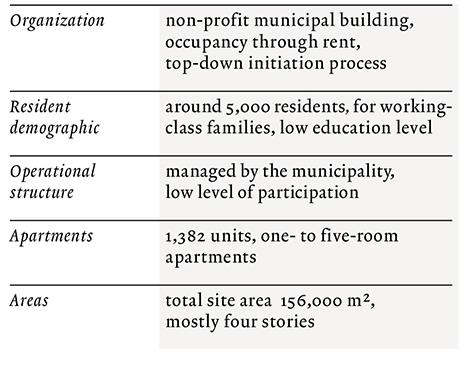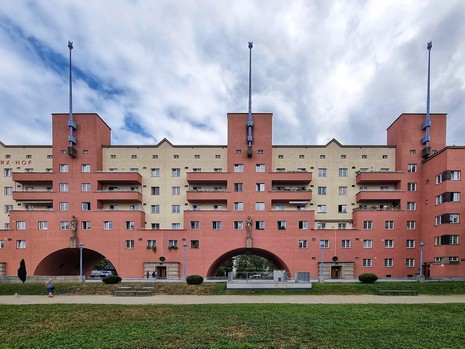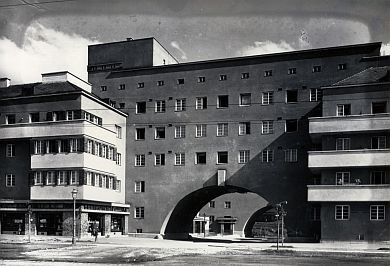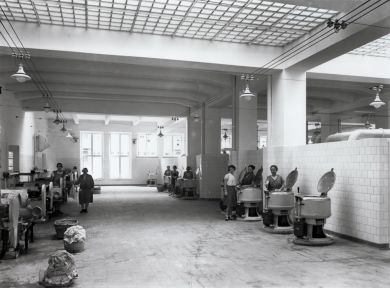Description
The inception of the social democratic government in Vienna, starting in 1918, was marked by soldiers returning from war and urgently in need of shelter and suffering from food scarcity, and soaring unemployment. Having lost the war, Vienna was heavily in debt.[1] Due to bitter necessity, derelict urban fields were initially made into so-called “board villages”, conglomerates of makeshift huts and kitchen gardens to provide the starving population with shelter and food.[2] Over the course of the next 15 years, however, the Red Vienna government was able to implement its municipal housing policy quite extensively. To finance the residential buildings, a system of indirect taxation of everyday goods was introduced, then converted into an earmarked housing tax in 1923. The tax was on a steep sliding scale, with the majority of the population paying only 2 percent and the highertaxed residents of the most expensive apartments accounting for almost half of the total tax revenue. All of the earmarked funds went to municipal housing construction, which had set itself the goal of building 5,000 apartments every year that would be new, modern, bright, and hygienically adequate, each with its own water connection and toilet.[3] The apartments were not only built according to the Garden City model preferred by avant-garde architects of the time, but were also realized as perimeter block developments or Courtyard Apartment Buildings, which typically feature courtyard access to the wings of the complex.[4]
One of the most striking buildings of the era is the Karl-Marx-Hof, built in 1927 by architect Karl Ehn, a student of Otto Wagner. As with all municipal apartment buildings, access was via the courtyard, an expression of cohesion and community. Initial occupancy of the Karl-Marx-Hof was around 5,000 residents in 1,382 one- to five-room apartments.[5] The complex was equipped with extensive collective facilities, including collective baths, a central launderette with 62 washing stations, two kindergartens, a maternity counseling service, a library, several clinics and medical practices, a tuberculosis care center, and a pharmacy.[6] The complex also included a post office, a restaurant, coffeehouses, shops, and assembly halls, some of which were used for political events. The collective living quarters and the additional infrastructure facilities were centrally located to encourage their use as meeting places for the community and even the surrounding neighborhood. Although the collective living spaces were extensive and varied, the design of the individual apartments emphasized privacy for families.[6] The apartments were not minimalistic, but designed with all the amenities common for the times, including an entry room that served as an intermediate zone and threshold to the more private areas.
 Selected project data
Selected project data
 Exterior view with entrances
Exterior view with entrances
 Karl-Marx-Hof with passage towards Felix-Braun-Gasse (photo 1930)
Karl-Marx-Hof with passage towards Felix-Braun-Gasse (photo 1930)
 Laundry area (photo 1930)
Laundry area (photo 1930)
Footnotes
Jahn (2014): Das Wunder des Roten Wien, Zwischen Wirtschaftskrise und Art Deco, p. 10.
Ibid., p. 24. 3.
Ibid., p. 15.
As Franz Musil, Head of the Vienna Building Authority, explained, Garden Cities were considered satellite cities, and the additional costs for infrastructure, schools, and public buildings, not to mention traffic thoroughfares and residential streets, was not affordable. See Jahn (2014): Das Wunder des Roten Wien, Zwischen Wirtschaftskrise und Art Deco, p. 20.
Reppé (1993): Der Karl- Marx-Hof, p. 34.
At the time, tuberculosis was widespread and was even dubbed the Vienna disease as a result of its high incidence in the city. Improved health conditions, including measures in housing, made it possible to cut occurrences of the illness in half.
Reppé (1993): Der Karl- Marx-Hof, p. 35 f.
Originally published in: Susanne Schmid, Dietmar Eberle, Margrit Hugentobler (eds.), A History of Collective Living. Forms of Shared Housing, Birkhäuser, 2019. Translation by Word Up!, LLC, edited for Building Types Online.